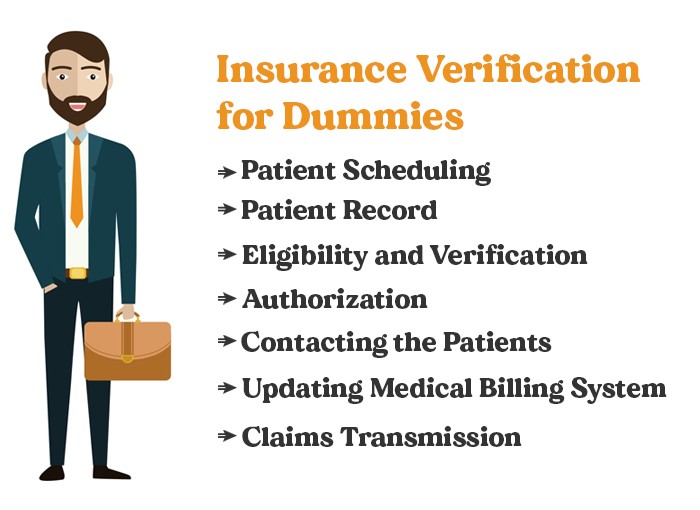Insurance Verification for Dummies
The process of insurance verification plays an important role in the healthcare industry. This is because insurance claims made by thousands of patients carry a huge risk of denied claims or fraud. Sometimes patients tend to make false insurance claims that are likely to affect the revenue cycle of hospitals. However, not every individual is aware of the complexity of the process and its importance in medical practice. Therefore, everyone must understand the process of insurance verification and its role in providing medical care to thousands of patients while getting maximum reimbursement. The following are the steps involved in insurance verification to help individuals comprehend the idea of verifying claims.
Patient Scheduling
The process of insurance verification begins with patient scheduling. It involves gathering data that is relevant to schedule a patient’s appointment. Patient scheduling may be done via phone text, fax, or email. The facility of self-scheduling is available in a lot of hospitals. Scheduling helps make the process more streamlined by reducing the number of people standing in long queues to get an appointment at the hospital’s reception.
Patient Record
This involves gathering a patient’s demographic information and medical history to maintain a proper record of medical issues, diagnosis, and treatment. Recording the patient’s demographic and medical data is quite essential in the verification process.
Eligibility and Verification
The medical insurance verification company verifies the insurance claims made by the patients. It is where the data in the patient record becomes quite useful. The patient record helps the insurance verification specialist to identify the patient, and cross-check his/her insurance claim with the insurance provider. The verification specialist verifies the details like the patient’s name, date of birth, insurance ID, etc.
Authorization
This step includes acquiring approval from the coverage issuer before the provider is rendered. Failure to acquire prior authorization can bring about claim denial, leaving sufferers to endure the price out of pocket. By streamlining the authorization technique, healthcare providers can mitigate such dangers and make sure of well-timed reimbursements.
Once the claim has been verified the insurance verification specialist ensures to authorize the claim. This obliges the insurance provider to pay the promised amount without any failure.
For healthcare agencies, integrating computerized pre-authorization tools into their workflows can substantially lessen delays. These gear assist the healthcare body of workers control authorizations greater efficaciously, improving each patient’s results and monetary balance.
Contacting the Patients
The verification specialist is required to follow up with the patients to update them about the progress made in insurance claim verification. Once the claim has been tested and licensed, it’s crucial to keep the sufferers informed. Insurance verification professionals follow up with sufferers to update them on the development and status of their coverage claims.
Clear and timely communication builds consideration among healthcare companies and patients. It additionally allows sufferers to apprehend any capability out-of-pocket expenses they might incur. In instances of claim denial, this step gives sufferers the possibility to explore alternative options, inclusive of appealing the choice or discussing fee plans with the issuer.
Updating Medical Billing System
This helps in keeping track of payment details to make claims submission successful and error-free.
A nicely-maintained billing system guarantees that says are submitted blunders-unfastened, reducing the probabilities of denial or rejection. Additionally, it enables tracking excellent payments, reconciling bills, and identifying discrepancies. Modern billing systems ready with automation features simplify this system, permitting healthcare companies to be cognizance of delivering great care.
Claims Transmission
Claims can be transmitted both electronically or manually. Electronic submissions are quicker and greater dependable, as they decrease the chance of human error and offer faster feedback at the claim’s fame. Manual submissions, although much less commonplace today, may also nonetheless be utilized in precise cases wherein electronic techniques are unavailable.
Healthcare providers must constantly make certain that says are submitted with all of the essential documentation and in the stipulated timeframe. Delays or incomplete submissions can lead to denied claims, which may disrupt the revenue cycle.
Conclusion
Insurance verification might look like a daunting system, but when damaged down into achievable steps, its importance will become clean. From patient scheduling to claims transmission, each level plays an essential function in making sure correct reimbursements and uninterrupted care shipping.
By adopting cutting-edge tools and technology, healthcare companies could make the coverage verification procedure faster and greater dependable. For sufferers, information this procedure fosters transparency and consideration, creating a better average healthcare revel in.
Whether you’re a healthcare professional or a curious individual, understanding the intricacies of coverage verification is important to navigating the complexities of scientific claims in these days’s healthcare landscape.




